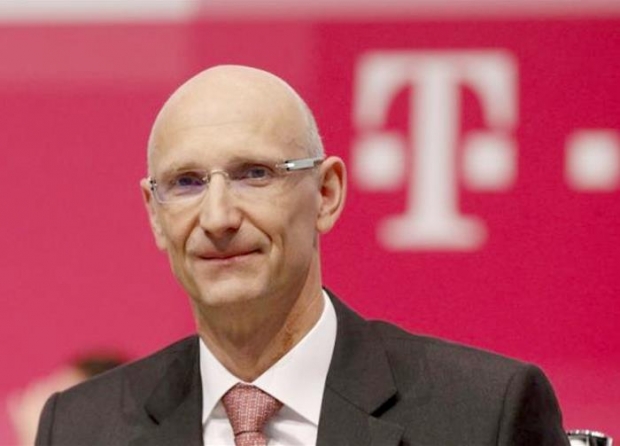
Growth accelerates: Deutsche Telekom exceeded its financial targets for the 2015 financial year. The Group generated adjusted EBITDA of 19.9 billion euros in the past financial year. The original guidance for 2015 was 18.3 billion euros. As a result of the increase in the U.S. dollar exchange rate in the last year to 1.11 U.S. dollars per euro, this corresponds to adjusted EBITDA of some 19.4 billion euros, according Deutsche Telekom. Taking into account this exchange rate adjustment as well as a number of one-time effects, reported adjusted EBITDA thus exceeded the prior-year level by 6.2 percent and was well above the guidance. "Deutsche Telekom was extremely successful on both sides of the Atlantic in 2015," said CEO Tim Höttges (photo). "We are continuing on our path to becoming the leading European telecommunications provider with further strong investments in the future this year."
Free cash flow of 4.5 billion euros at year-end also clearly exceeded the guidance of 4.3 billion euros. Exchange rate effects played only a subordinate role here.
Deutsche Telekom recorded double-digit revenue growth in 2015 of 10.5 percent compared with the prior year to 69.2 billion euros. In organic terms, i.e., adjusted for exchange rate effects and changes in the composition of the Group, revenue increased by 3.0 percent.
The Group invested even more than in the prior year in its networks in Europe and the United States. Cash capex excluding expenses for mobile spectrum rose by 13.5 percent to 10.8 billion euros. There was also strong growth in net profit, which increased by 11.3 percent to 3.3 billion euros. This corresponds to earnings per share of 0.71 euros. Adjusted for special factors, net profit increased by almost 70 percent year-on-year to 4.1 billion euros.
Based on the results achieved, the Board of Management and Supervisory Board will propose to the shareholders’ meeting on May 25 a dividend of 0.55 euros per share, 10 percent more than in the prior year. Thus, the amount of the dividend is being increased in line with the growth in free cash flow, as announced at the Capital Markets Day in 2015.
Germany – Rising customer numbers thanks to systematic network build-out
Deutsche Telekom achieved its strongest growth to date in a single quarter in terms of the number of fiber-optic lines (FTTC and FTTH), which increased by 532,000 between October and December to 4.4 million. This resulted in a total increase for the 2015 full year of 73.5 percent.
Substantial growth in superfast lines proved once again to be a strong driver for the marketing of the Internet-based television service Entertain. Around 40 percent of new fiber-optic customers in the roll-out areas book Entertain. In the fourth quarter, the Group recorded 51,000 new Entertain customers, taking the total number to 2.7 million. And the number of MagentaEins customers reached the two million mark at the end of the year.
Deutsche Telekom built on its position as the German mobile market leader in service revenues in the fourth quarter of 2015. While the overall market declined by around one percent in this quarter, the decrease in Deutsche Telekom's service revenues was less pronounced, at 0.4 percent, falling to 1.7 billion euros. This slight decline in revenue was attributable to customer discounts in connection with the successful marketing of MagentaEins. Telekom's market share increased by 0.2 percent in the full year.
Total revenue in the Germany segment increased by 0.7 percent year-on-year to 22.4 billion euros in 2015. Adjusted EBITDA remained stable compared with 2014, down just 0.2 percent to 8.8 billion euros.
United States – Growth in customer numbers and profitability
T-Mobile US grew much faster than the other mobile operators in the United States in 2015 and at the same time managed to substantially improve profitability. The total number of customers of the new number three in the U.S. mobile market rose by 8.3 million to 63.3 million as of the end of the year. This included 31.7 million branded postpaid customers, an increase of 4.5 million over the course of the year. Overall, the trend in customer numbers in the United States continues to show a clearly positive balance in relation to every single competitor of T-Mobile US.
Revenue increased by 8.1 percent to 32.1 billion U.S. dollars compared with 2014. Service revenues grew much faster, rising 11.7 percent to 24.3 billion U.S. dollars; in the fourth quarter alone, service revenues grew by 12.9 percent. At the same time, adjusted EBITDA increased by 29.5 percent to 7.4 billion U.S. dollars.
The formula for T-Mobile US' success are the numerous initiatives of the Un-carrier strategy. These include, for example, JUMP! – the program allowing device upgrades in return for a monthly charge. By the end of the year, 13.3 million customers had chosen this option, 43 percent more than a year earlier. A further component of the market success is the systematic build-out of the network. T-Mobile US' LTE network now reaches 304 million people compared with 265 million a year earlier.
Europe – Success with integrated offers
Network build-out and integrated offers were among the leading issues for the European national companies in the past financial year. The LTE mobile networks reached coverage of 71 percent of the population by the end of 2015, compared with just 47 percent one year before. Hungary and Greece already have network coverage of 97 and 82 percent respectively. In the fixed network, the number of households with an available bandwidth of more than 100 Mbit/s increased from 2.9 million to 3.7 million in the last year.
Product packages combining mobile and fixed-network offerings under the names MagentaOne and CosmoteOne in Greece enjoyed great success right from the start. As of year-end, around a million customers across Europe were already using the offers.
Revenue in the Europe segment fell 2.0 percent year-on-year in 2015 to 12.7 billion euros. Growth areas such as mobile data business and the business customer segment (B2B/ICT) partially offset the declines in traditional telecommunications business. Adjusted EBITDA declined by 3.2 percent to 4.3 billion euros compared with 2014. These results for the segment are based on widely varying trends in the individual countries, with the national companies in Greece, Hungary, and Austria recording very positive figures in their domestic markets in comparison with the competition.
Systems Solutions – Market Unit grows steadily
Revenue in the Market Unit, which mainly comprises T-Systems' external business, grew somewhat faster than the overall market in 2015, up 2.6 percent to 7.1 billion euros. There was a positive trend in the most important earnings indicator, adjusted EBIT, which rose by 40 million euros or 24.4 percent to 204 million euros. This resulted in an adjusted EBIT margin in the Market Unit for 2015 of 2.9 percent, up from 2.4 percent the year before.
T-Systems recorded a clear increase in the growth area of cloud, generating revenue of almost one billion euros in 2015, up 24 percent on the previous year.
Order entry declined substantially by 19.5 percent. However, this key performance indicator grows less and less important in the cloud environment. Services are often recorded on a usage basis and not billed at a flat rate. As a result, order volumes upon concluding agreements are much lower than previously. Against this background, billion euro deals are a major exception.
2015 Annual Report provides "Answers for the digital future"
We are letting a variety of people have their say in our 2015 Annual Report – from the Board of Management to our employees and customers to our partners. They are asked questions on the topic of digitization, to which they give highly varied responses; they all provide "Answers for the Digital Future". Our new Annual Report also looks specifically at different topic areas where Deutsche Telekom is already investing in and developing the digital future. The online Annual Report can be accessed at www.annualreport.telekom.com.





